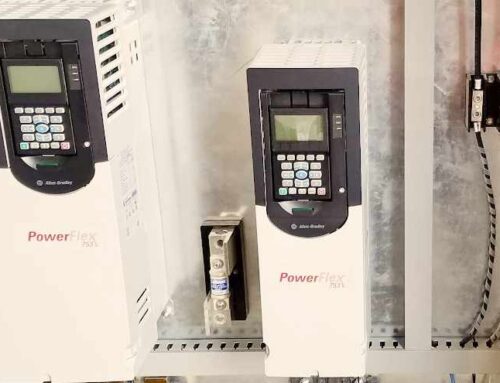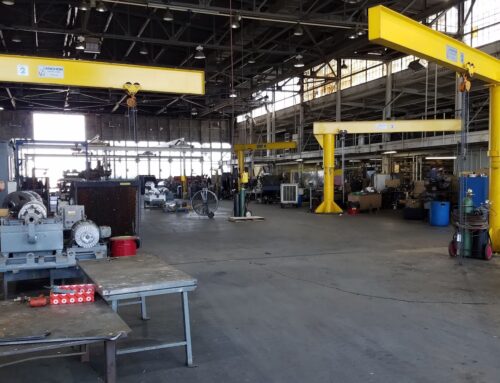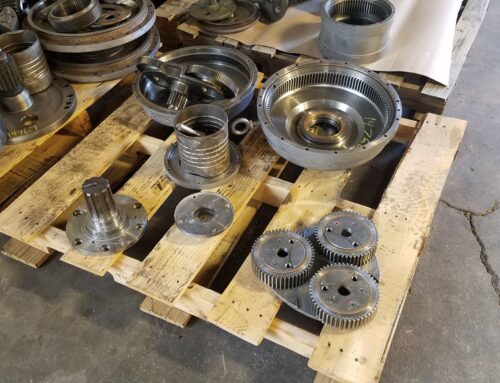A decanter centrifuge is basically a rotating solid bowl centrifuge with a screw conveyor placed inside it with a shape matching the bowl shape with a small gap, 1/8th inch or so, between the edge of the conveyor flights and the inside bowl wall. The bowl usually has a cylindrical section and a conical section (called the beach). A few models are cone shaped for the entire bowl length. The feed slurry containing a liquid and some solids that will “settle” (not float) enter via a non-rotating feed tube stuck into one end and held in place by the “feed tube yoke.” The feed emerges from the feed tube into a hollow chamber inside of the conveyor hub. The “feed zone” of the conveyor has holes in the rotating surface allowing the slurry to splash out into the bowl between “flights” of the conveyor. The feed (during rotation of the centrifuge) spreads out 360 degrees around the bowl wall and takes a helical path between flights in both directions from the feed ports. The slurry fills the bowl to part way up the beach then no more that way. Going the other way it flows to the other end of the bowl where holes are present in the “liquid end hub” and it emerges there or “decants” over the hole edges, just by having more slurry come in behind it. Liquid filling a vessel will emerge at the “lowest” point. The centrifuge is covered with a casing cover and the discharged liquid drains out of the lower casing chute at one end.
While the slurry is moving towards the liquid discharge end it is under a “moment of inertia” force due to the rapid rotation of the bowl. This can be calculated as an acceleration with 1 G-Force (Gravitational Force) being 32 feet per second per second. In daily life we know that a certain mass of atoms has a weight of one pound, just by definition under 1 G. We weigh so many pounds each as we stand at sea level on planet Earth. In Colorado with its’ higher elevation you weigh less than in Atlantic City.
A particulate will settle in water under 1 G in X amount of time. Just pour salt in a glass of water. If we increase the G to 2 G’s it will settle twice as fast (almost, viscosity of the water plays a small role). A decanter centrifuge is usually operating at nearly 3,000 x G’s, or more. Three thousand G’s! It takes very little time for a particulate to settle 2 inches or so in the liquid pond of a decanter under 3,000 G’s.
Note the decanter schematic included here. The dry beach is the part above the top of the liquid pond. Under the pond the conical section is called the wet beach. The cylindrical length of the bowl is where the settling and clarification of the feed liquid takes place.
When the particulates reach the bowl wall they fill the small gap between the conveyor edge and the bowl and keep piling up. Now along comes a conveyor flight, rotating at a few RPMs different from the bowl RPM, and pushes the settled solids towards the cake discharge end of the decanter. The solids pile up in front of all the flights with more and more solids the closer they get to the cake discharge end. The solids are pushed up the beach and out of the pool onto the dry beach where any excess liquid drains back down into the pond. The firm dry looking solids are conveyed over holes at the top of the cone where the G force causes them to be flung out into the casing and they then drop down usually to a belt or screw conveyor that moves them away for disposal or further treatment or packaging. Sometimes a dumpster or dump truck can be parked directly under the centrifuge cake discharge thus eliminating the conveyor. Some cake discharges are of a thick pudding or paste like consistency and a positive displacement pump can be used to transport the solids away.
The gearbox on the end (usually but not always on the liquid end) is bolted to the bowl and rotates at the bowl speed. The conveyor is separated from the bowl by bearings and is connected to the shaft of the gearbox and thus to the gears inside the gearbox. By action of the gears the conveyor is kept at a different speed or RPM compared to the bowl. This difference in RPM is needed to move the solids down the bowl, up the beach and out of the decanter. This difference in RPM is usually from 5-30 RPM. This is called the “differential speed” or “differential RPM” or just “differential.” The differential can be adjusted which is beneficial in optimizing the performance of the decanter in making the separation. A secondary or “backdrive” motor is connected to the external gearbox “pinion” shaft. The pinion shaft is connected to the gearbox gears on the opposite side of the gearbox from the conveyor. A change in the pinion RPM results in a change in the conveyor RPM.
Decanter centrifuges are usually manufactured in 316 stainless steel or a close variation of 316 with more strength under rotation (317, Duplex). Care should be taken in matching the centrifuge material of construction to the corrosive properties of the feed slurry, solids, or vapors. The objective is to have zero corrosion on the centrifuge metal. Other centrifuge materials of construction can be carbon steel (mining or high oil content applications such as meat industry rendering), 304 and other stainless steels, several grades of Hastelloy, titanium, and one or two other exotic metals. Any special order metal centrifuges are extremely expensive compared to the standard metals.
Additional articles on decanters can be found on our web site.




